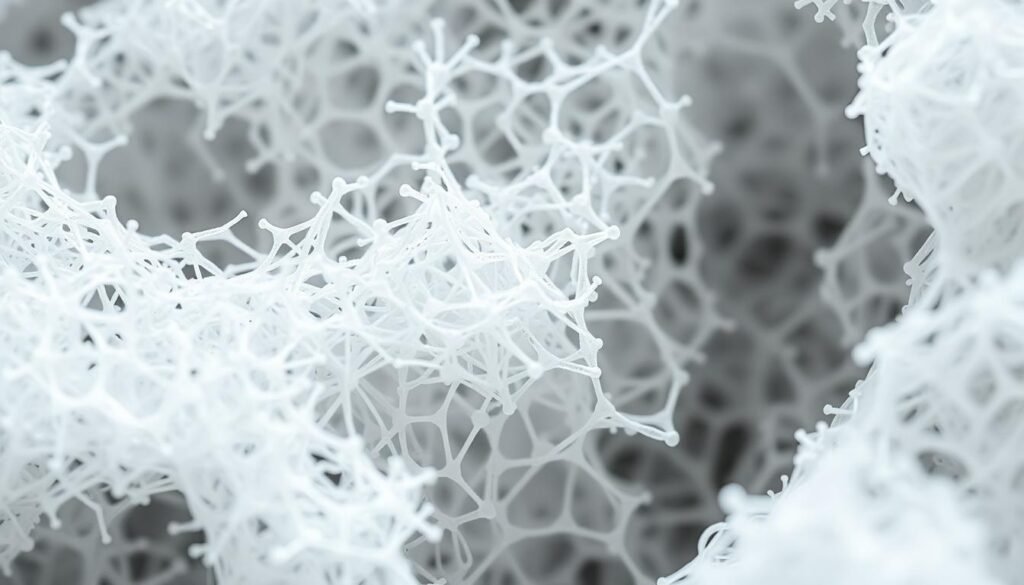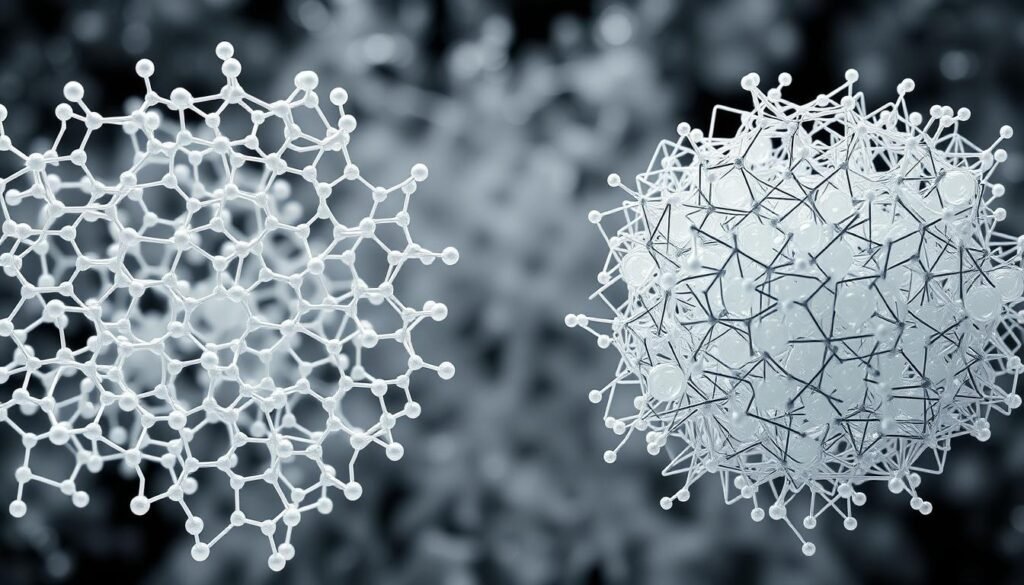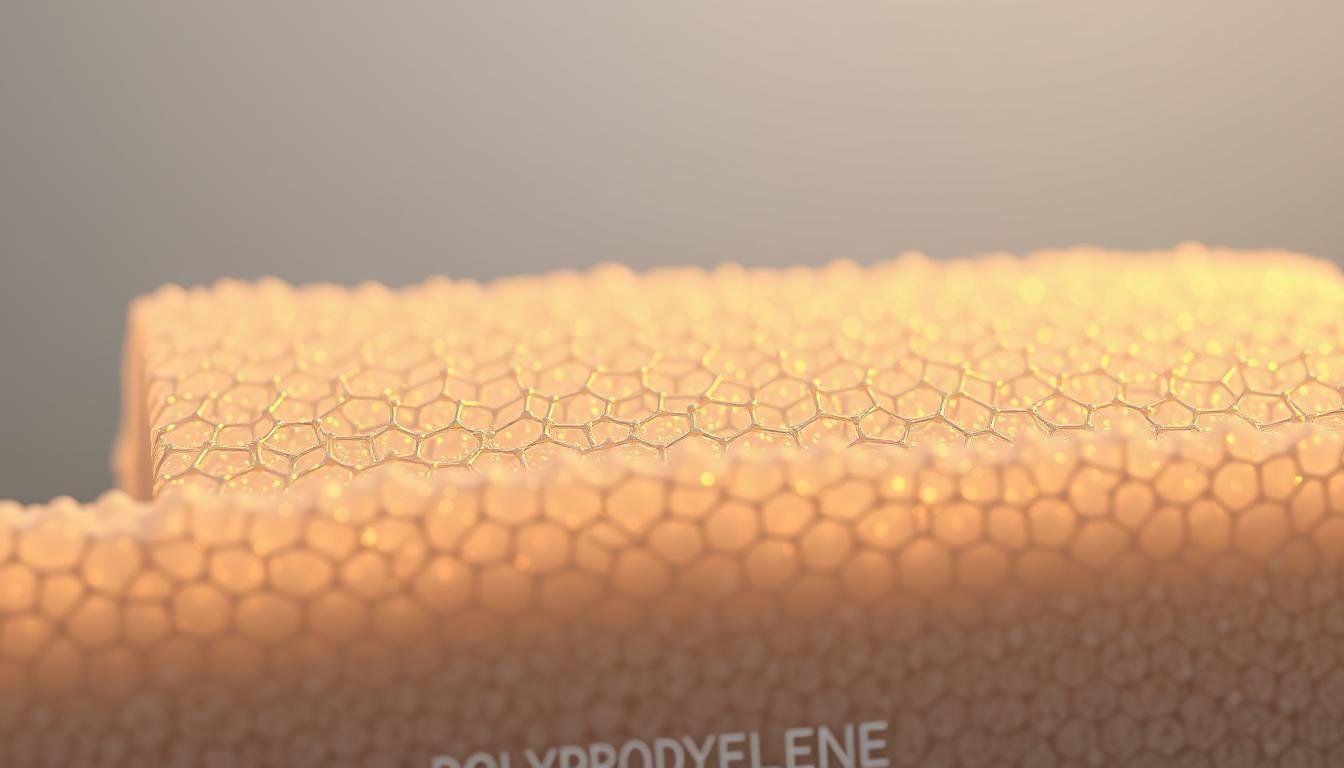Polypropylene (PP) is a common thermoplastic made from propylene. It has a density between 0.90 g/cm³ and 0.94 g/cm³. This density is key to understanding its polypropylene characteristics.
These characteristics help decide which type of polypropylene is best for different uses. It’s used in everything from packaging to car parts. Its light weight and flexibility make it great for building and everyday items.
Introduction to Polypropylene
Polypropylene is a widely used thermoplastic in today’s industries. It’s light and strong, making it perfect for many uses. It shines in packaging, car parts, and textiles.
First made in the 1950s, polypropylene has grown a lot. Now, it comes in different types that change its density and strength.
Polypropylene is versatile and durable. It’s easy to work with and mold. This makes it a key player in modern manufacturing.
As companies try new things, polypropylene keeps getting better. It’s changing the game in many fields.
| Characteristic | Details |
|---|---|
| Density | 0.90 – 0.91 g/cm³ |
| Melting Point | 160 – 170°C |
| Tensile Strength | 30 – 50 MPa |
| Elongation at Break | 300 – 600% |
| Thermal Conductivity | 0.1 – 0.2 W/(m·K) |
Knowing about polypropylene’s properties helps use it better. It’s great for both looks and function in industries.
What is Density in Plastics?
Knowing the density definition is key when looking at plastic materials. Density shows how much mass is in a given volume. It’s usually measured in grams per cubic centimeter (g/cm³) or kilograms per cubic meter (kg/m³).
Density affects many things in plastics, like strength and stiffness. A higher density means a stronger product that can handle more stress. On the other hand, lighter plastics are cheaper and easier to carry.
| Plastic Type | Density (g/cm³) | Mass per Unit Volume (kg/m³) |
|---|---|---|
| Polypropylene | 0.90 – 0.92 | 900 – 920 |
| PS (Polystyrene) | 1.04 | 1040 |
| PE (Polyethylene) | 0.92 – 0.97 | 920 – 970 |
| ABS (Acrylonitrile Butadiene Styrene) | 1.04 – 1.06 | 1040 – 1060 |
When picking materials, engineers and designers must think about density. It helps them make better choices for products and manufacturing. This way, they can create things that are both strong and cost-effective.
Understanding the Density of Polypropylene
Polypropylene is a common thermoplastic used in many products. Knowing its density is key for its use in different fields. Its density ranges from 0.90 g/cm³ to 0.94 g/cm³, depending on how it’s made.
Definition and Measurement
Measuring polypropylene’s density is done through specific tests. This ensures the right density is picked for each use. Tools like hydrostatic weighing and density gradient columns are used to get accurate results.
Variability of Density
Density in polypropylene can change due to several reasons. These include the molecular weight and how it’s made. For example, lighter polypropylene is good for packaging, while denser types are better for strong parts.
| Density Grade | Typical Density (g/cm³) | Applications |
|---|---|---|
| Low-Density Polypropylene (LDPP) | 0.90 – 0.91 | Packaging, Films, Consumer Goods |
| Medium-Density Polypropylene (MDPP) | 0.92 – 0.93 | Containers, Automotive Parts |
| High-Density Polypropylene (HDPP) | 0.94 | Housings, Industrial Parts |
Factors Affecting the Density of Polypropylene
The density of polypropylene is key to its use and performance. Several factors, like molecular weight and structure, affect this density. Knowing these helps in choosing the right material and processing methods.
Molecular Weight and Molecular Structure
Molecular weight is a big factor in polypropylene’s properties. Higher molecular weight means more rigidity and strength. This makes high-density polypropylene great for applications needing strong mechanical properties.
On the other hand, lower-density polypropylene is more flexible but less strong. The structure of polypropylene also plays a role. How well the molecular chains are organized affects the density. More crystallinity means higher density, which impacts the material’s performance.
| Molecular Weight | Density (g/cm³) | Crystallinity (%) | Mechanical Strength (MPa) |
|---|---|---|---|
| Low Molecular Weight | 0.85 | 30 | 20 |
| Medium Molecular Weight | 0.90 | 50 | 30 |
| High Molecular Weight | 0.95 | 70 | 40 |
Importance of Low-Density Polypropylene
Low-density polypropylene (LDPP) is key in many industries because of its special traits. It’s light, which is great for things that need to be lighter. This is super useful in packaging, where keeping things light but strong is important.
LDPP is also used in making cars lighter, disposable items, and flexible goods. It shows how versatile and useful this material is. It meets the needs of today’s makers.
LDPP is flexible, which makes it great for many uses. This flexibility makes products better and helps the environment. It makes things lighter, which means less fuel is used when moving them.
| Application | Description | Benefits |
|---|---|---|
| Packaging | Used in bags, wrappers, and containers | Lightweight and strong, reducing shipping costs |
| Automotive | Components for lightweight vehicles | Improved fuel efficiency and performance |
| Consumer Goods | Household items and disposable products | Cost-effective and flexible, catering to diverse needs |
High-Density Polypropylene: Characteristics and Applications
High-density polypropylene is known for its durability and strong mechanical properties. It’s a top choice in many fields. Its high tensile strength and resistance to deformation make it last longer in tough uses.
Mechanical Properties
High-density polypropylene stands out for its mechanical strength. It’s stiffer and stronger than other types. This makes it perfect for situations where materials need to be very strong.
Applications in Industrial Use
HDPP is used in many industries because of its versatility. It’s used for:
- Automotive parts, ensuring safety and efficiency
- Chemical containers, standing up to harsh substances
- Construction components, handling heavy loads
These uses show how important HDPP is for reliable products in tough settings.

| Feature | Attribute |
|---|---|
| Tensile Strength | High resistance to breaking under tension |
| Deformation Resistance | Minimal change in shape under stress |
| Stiffness | Greater rigidity, ideal for structural applications |
| Durability | Long-lasting performance in harsh environments |
Impact of Density on Polypropylene’s Physical Properties
Density has a big impact on polypropylene’s physical properties. Changes in density affect important traits like stiffness, strength, and how well it holds up to heat. For example, higher density polypropylene is stiffer and stronger. This makes it great for things like car parts and electrical boxes, where it needs to handle stress and heat well.
On the other hand, lower-density polypropylene is more flexible and can handle impacts better. This is really useful in packaging and for soft items, where it needs to be tough but also light. The right density of polypropylene can be chosen for different uses, thanks to its unique mix of properties.
| Density Range (g/cm³) | Property Impact | Typical Applications |
|---|---|---|
| 0.90 – 0.92 | Enhanced flexibility and impact resistance | Packaging materials, soft goods |
| 0.93 – 0.95 | Balanced stiffness and flexibility | Household products, textiles |
| 0.96 – 1.00 | Greater rigidity and heat resistance | Automotive parts, electrical components |
Polypropylene Production: Adjusting Density Through Processing
The making of polypropylene involves many factors that affect its density. Density adjustment in polypropylene production mainly happens by controlling the temperature and pressure of polymerization. This lets manufacturers tailor materials for different uses.
Polymerization Temperature Effects
The temperature during polymerization greatly affects polypropylene’s density and molecular weight. Higher temperatures make the material stronger and more durable. If the temperature gets too high, the molecular chains grow longer and more complex. This makes the material stiffer and stronger.
Pressure Variations During Polymerization
Changing the pressure during polymerization also changes the density of polypropylene. Higher pressure makes the material denser and better at carrying loads. Lower pressure results in a lighter material. So, adjusting the pressure is key to getting the right density for different uses.
For more on how these changes affect properties, check out the info here.
Comparing Isotactic and Atactic Polypropylene
Isotactic and atactic polypropylene are two types of polypropylene with different properties. They have unique structures that affect how they work in various uses. This part talks about their differences in density and crystallinity and how these impact their uses.
Differences in Density and Crystallinity
Isotactic polypropylene has a more organized structure. This leads to higher crystallinity and density. Its ordered methyl groups make it stronger and more heat-resistant. On the other hand, atactic polypropylene is more flexible and less dense because of its disordered structure.
The difference in crystallinity is key to how these polypropylenes perform. Isotactic polypropylene is known for:
- Higher melting points, making it suitable for applications involving heat resistance.
- Increased rigidity, beneficial for structural components and packaging materials.
Atactic polypropylene, though less dense, has its own benefits:
- Greater flexibility, appealing for applications like films and fibers.
- Lower density, making it lighter and easier to process in certain manufacturing scenarios.

Knowing these differences helps choose the right polypropylene for a task. It shows how important crystallinity is in determining material properties.
Density’s Influence on Thermal Characteristics
The thermal properties of polypropylene show how density affects thermal stability. Higher density polypropylene has higher melting points. This means it can handle more heat, making it great for car parts and electrical insulation.
On the other hand, low-density polypropylene is more flexible in cold temperatures but melts at a lower point. It’s perfect for items that don’t need to withstand high heat, like packaging and consumer goods.
Knowing how density affects thermal stability helps manufacturers pick the right polypropylene for their needs. Here’s a table that shows the thermal characteristics of different polypropylene densities:
| Polypropylene Type | Density (g/cm3) | Melting Point (°C) | Thermal Stability | Typical Applications |
|---|---|---|---|---|
| High-Density Polypropylene | 0.91 – 0.97 | 160 – 170 | Excellent | Automotive parts, electrical insulation |
| Low-Density Polypropylene | 0.85 – 0.90 | 100 – 130 | Good | Packaging, consumer products |
Chemical Resistance and Density Correlation
Polypropylene is known for its strong chemical resistance. This makes it great for many uses. The density of polypropylene affects its chemical resistance. High-density polypropylene (HDPP) is better at resisting chemicals, acids, and solvents than lower-density types.
This is key for industries that handle chemicals safely. HDPP’s tight molecular structure helps it block corrosive substances better. This is important for things like chemical tanks, pipes, and containers.
Knowing how density affects chemical resistance is vital. The table below shows how different polypropylene densities compare:
| Densities of Polypropylene | Chemical Resistance Level | Applications |
|---|---|---|
| Low-Density Polypropylene (LDPP) | Moderate | General packaging, consumer goods |
| Medium-Density Polypropylene (MDPP) | Good | Household items, automotive components |
| High-Density Polypropylene (HDPP) | Excellent | Chemical storage tanks, industrial containers |
Choosing the right polypropylene grade is critical for industrial uses. Knowing about density and chemical resistance helps manufacturers pick the best material for chemical tasks.
Environmental Considerations for Polypropylene Density
The environmental impact of polypropylene is big, mainly because of recycling and waste issues. Low-density polypropylene is often used in single-use items like packaging. This leads to more plastic waste in landfills and oceans. It also makes us worry about plastic production’s long-term sustainability.
But, high-density polypropylene can be made to be better for the planet. By using high-density materials, makers can create products that last longer and are easier to recycle. This helps us move towards more sustainable ways of making plastic.
| Polypropylene Type | Density (g/cm3) | Common Uses | Environmental Impact |
|---|---|---|---|
| Low-Density Polypropylene | 0.90 – 0.91 | Packaging, Containers | Higher waste generation due to single-use applications |
| High-Density Polypropylene | 0.94 – 0.96 | Tubing, Containers | Better recyclability and durability |
To tackle polypropylene’s environmental impact, we need to cut down on waste and improve recycling. New ideas in making plastic more sustainable are key. They help reduce our ecological footprint while meeting our needs.

Conclusion
The density of polypropylene is key to its performance in many uses. It affects the material’s strength, flexibility, and how well it handles heat. Knowing about density helps makers create polypropylene that fits specific needs.
Understanding polypropylene’s density is vital as industries grow. By changing how polypropylene is structured, makers can make it better for certain uses. This versatile material can handle a wide range of needs, thanks to its density.
Getting to know polypropylene’s density is important for making materials better and more sustainable. As we learn more, we can make things more efficient and meet new market needs. For more on polypropylene, check out Wikipedia.
